- Destinations
- Travel Styles
- About Us
- Contacts
- Destinations
- Travel Styles
- About Us
Thailand is not only a place to taste amazing street food, shop at will in the liveliest night markets, but also a place to experience the special Buddhist culture of the country. One of the experiences not to be omitted while visiting Thailand is visiting sacred temples. Join us on the visit to the 11 most beautiful temples in Thailand, where one may admire unique architecture, learn the history of Buddhism, and find his or her inner peace.
Situated in the royal area of Rattanakosin, within the Grand Palace, is Wat Phra Kaew, Thailand’s most famous and beautiful Buddhist temple.
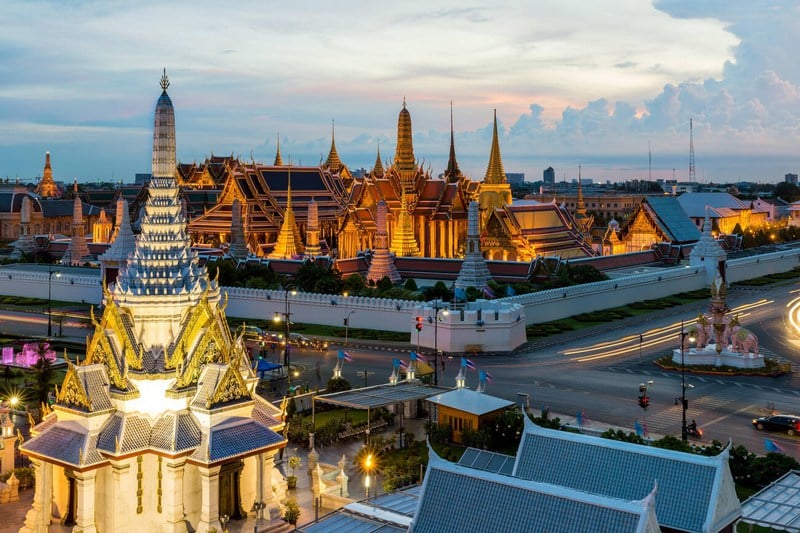
Built in 1782, when Bangkok became the new capital under the reign of King Rama I, this lavish temple houses the most revered statue in Thai Buddhism: the Emerald Buddha (which is actually carved from jade). Measuring just 66 centimeters, this iconic statue rests on a gold pedestal beneath a nine-tiered golden parasol—a symbol of royalty.
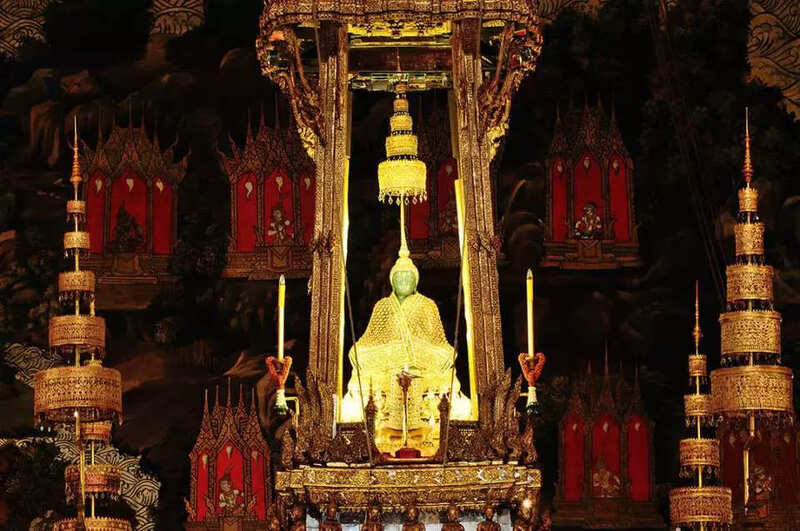
Surrounding the temple are multicolored mosaics, statues of mythological creatures, and a golden chedi enshrining Buddha's sternum. Inside the temple’s library, columns and walls are coated with green porcelain and hold sacred Buddhist texts.
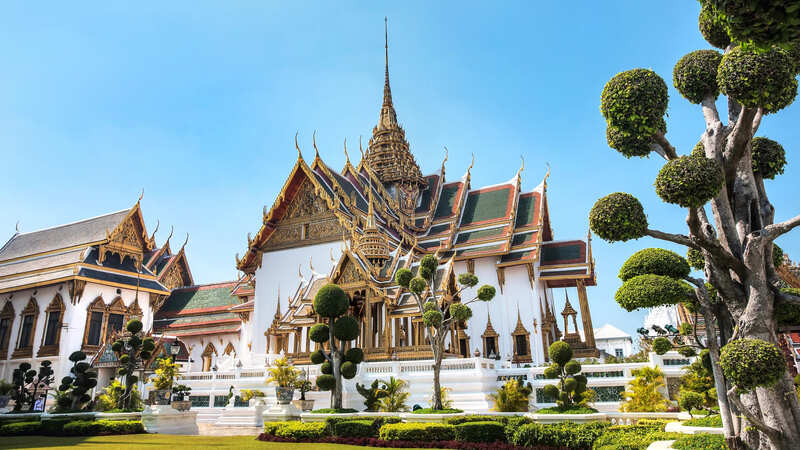
>>> Note: One of Thailand’s most popular sites, this location attracts both tourists and Thai devotees who come to worship the Emerald Buddha. For an optimal visit, arrive when it opens at 8:30 am, and book your tickets online to avoid crowds and queues. Proper attire is required: long pants or skirts and covered shoulders.
Wat Arun is one of Bangkok's iconic architectural treasures. Its main tower rises approximately 79 meters high and is adorned with millions of pieces of multicolored Chinese porcelain, each shining like a diamond under the sun. The name "Temple of Dawn" reflects its exceptional beauty at sunrise, offering a spectacular view at this time of day.
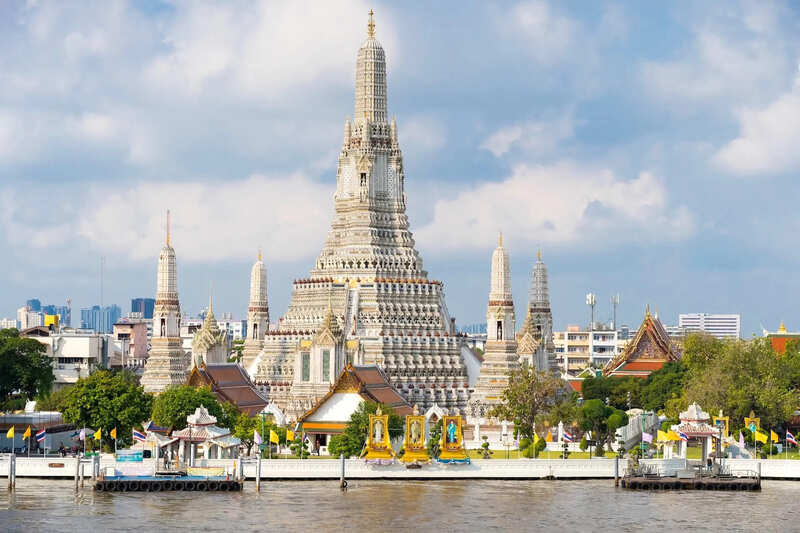
Dating back to the Ayutthaya era in the 17th century, Wat Arun was expanded and lavishly decorated during the reigns of Kings Rama II and III of the Chakri dynasty. Located in a prime position on the west bank of the Chao Phraya River, directly opposite the Royal Palace and the Wat Phra Kaew temple complex, it offers easy access for visitors to many tourist sites.
Wat Arun is also well-known for its large religious festivals and activities. During Buddhist festivals, such as Buddha's Birthday and Loy Krathong, thousands of lanterns and candles illuminate the temple, creating a fairytale-like and lively atmosphere.
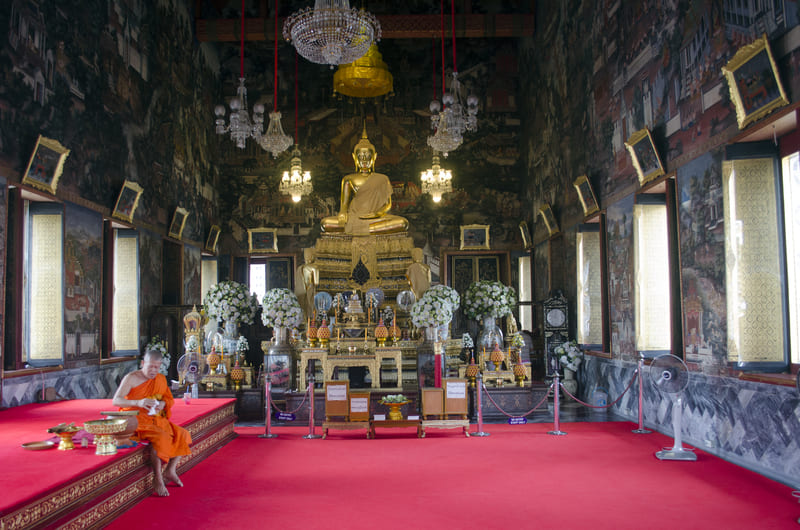
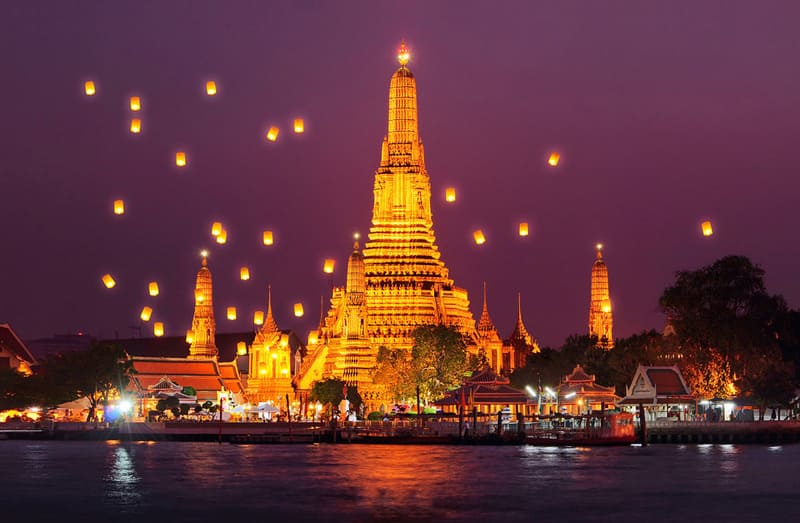
>>> Note: For an unforgettable experience at Wat Arun, it is recommended to visit this beautiful temple in the early morning or late afternoon to avoid the crowds. Be sure to dress appropriately, covering your shoulders and legs during your visit. Don’t miss the opportunity to admire Wat Arun illuminated at night, when the “Temple of Dawn” reflects like a mirage in the river’s waters. You can enjoy this magical view from the terrace bar at the Arun Residence Hotel, located on the opposite side of the Chao Phraya River.
On the banks of the Chao Phraya River and just steps from the Grand Palace, Wat Pho is an oasis of peace in the heart of Bangkok. This Buddhist temple was built over a century, beginning in 1788, and any traveler in search of serenity should pay a visit.
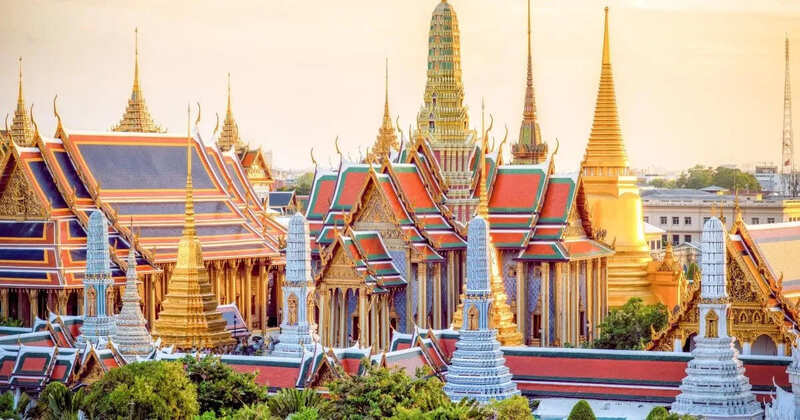
Its most precious treasure? A giant statue of a reclining Buddha, 45 meters long and 15 meters high, entirely gilded. This stunning depiction of the Buddha on his deathbed, just before reaching nirvana, is a marvelous sight to behold.
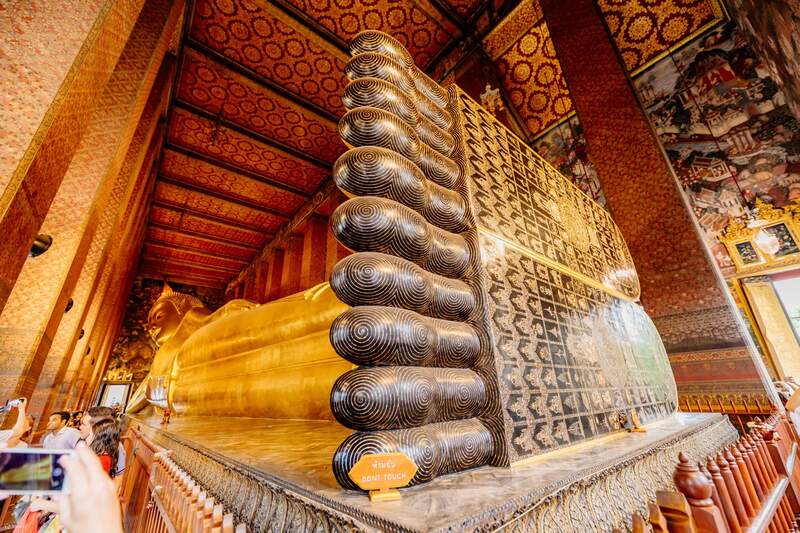
But Wat Pho is more than just this iconic statue. Its green gardens are home to numerous small temples, four magnificent chedis with slender spires, and two galleries where nearly 400 seated Buddhas appear to meditate in silence. The daily presence of monks, along with these serene elements, serves as a reminder that Wat Pho is much more than a tourist attraction.
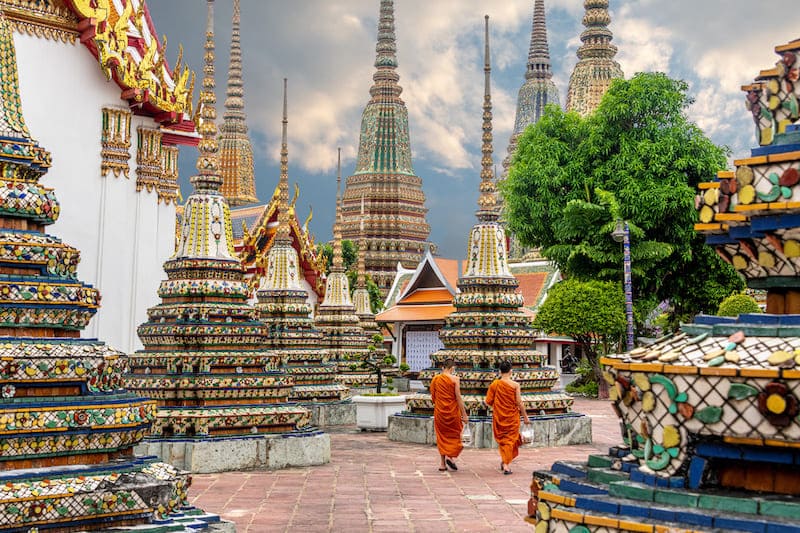
For a complete experience, indulge in a traditional Thai massage by the temple's apprentice masseurs—a soothing interlude not to be missed before continuing your exploration of Bangkok!
Considered one of the holiest temples in Chiang Mai province, Wat Phra That Doi Suthep features architectural elements richly infused with Thai Buddhist culture. The temple’s structures, clad in gold and granite, radiate a unique and magical splendor under the sun.
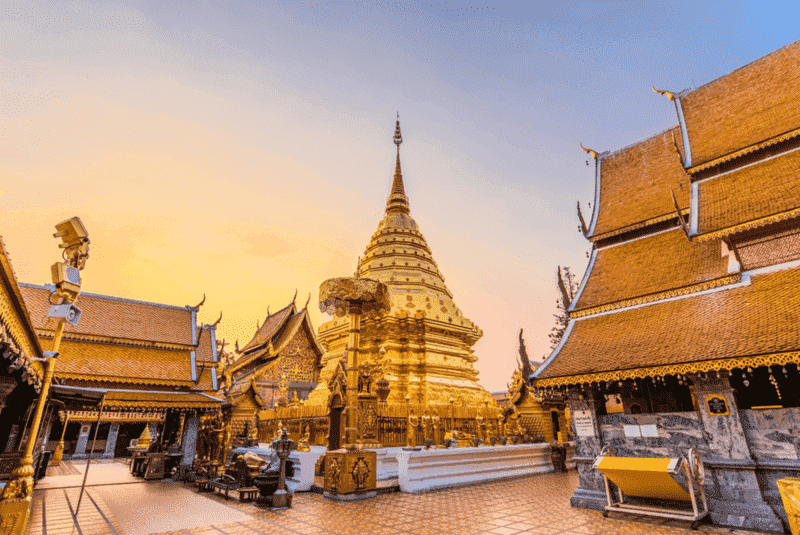
Outside the main temple stands the Chedi, a massive structure and the tallest tower on the temple grounds. This sacred place was chosen to house the relics and artifacts of the Buddha, some thousands of years old. Surrounding the tower are small golden Buddha statues on all four sides, posed as protectors to safeguard the spiritual serenity of the Buddha.
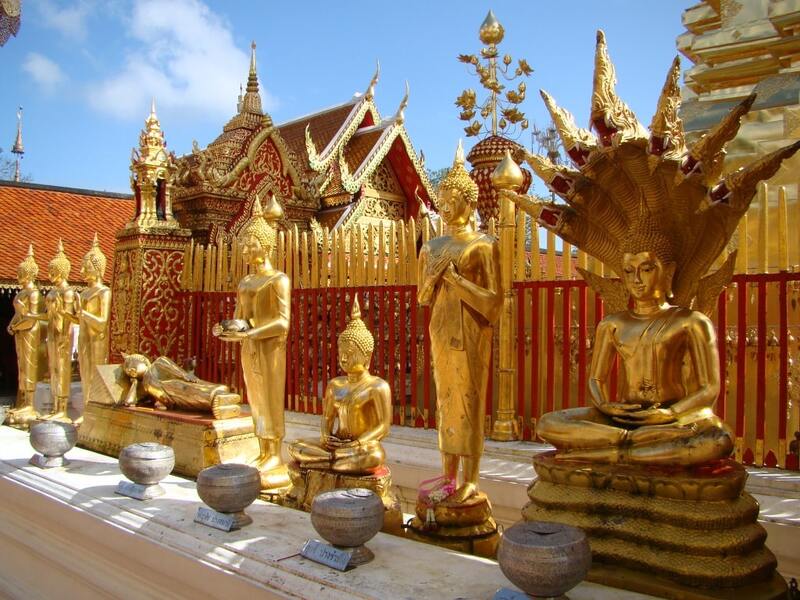
According to a local legend passed down by the people of Chiang Mai, if you light incense and, with complete sincerity, walk around the Chedi three times, you will be granted good fortune and blessings.
>>> Please note:
>>> Explore the northern city of Thailand with our article: Complete travel guide to Chiang Mai
Known for its striking white color, the White Temple of Wat Rong Khun is one of the most iconic landmarks in Chiang Rai. The artworks here provide concrete evidence of the artist's imaginative blend of Buddhist concepts concerning heaven, hell, karma, and earthly sins. The temple’s whiteness symbolizes the purity of Buddha.
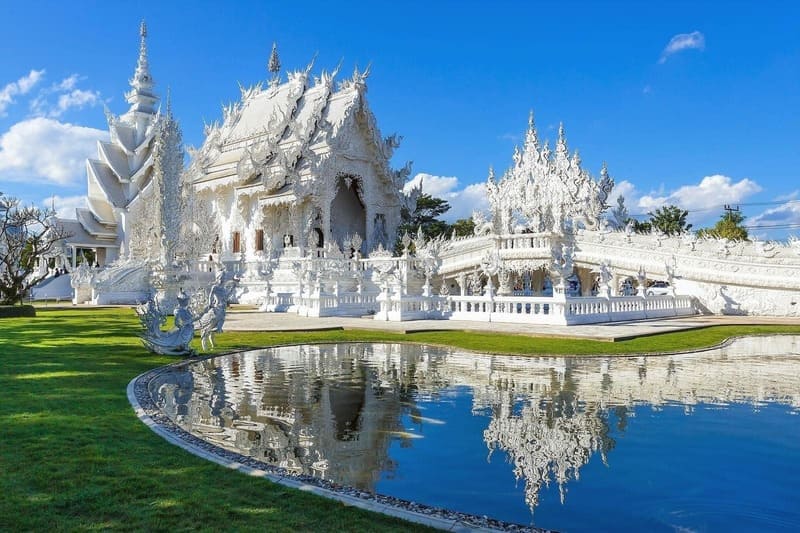
The most prominent structure in the White Temple complex is the sanctuary, a pure white building with a unique design that represents the heavenly kingdom. To enter, visitors must cross the "Cycle of Rebirth" bridge, where hands rise up symbolizing human desires and ambitions, and then pass through the gate of heaven, guarded by two enormous mythical creatures, before reaching the sanctuary. Surrounding the temple is a park with a pond and many intriguing hand-carvings.
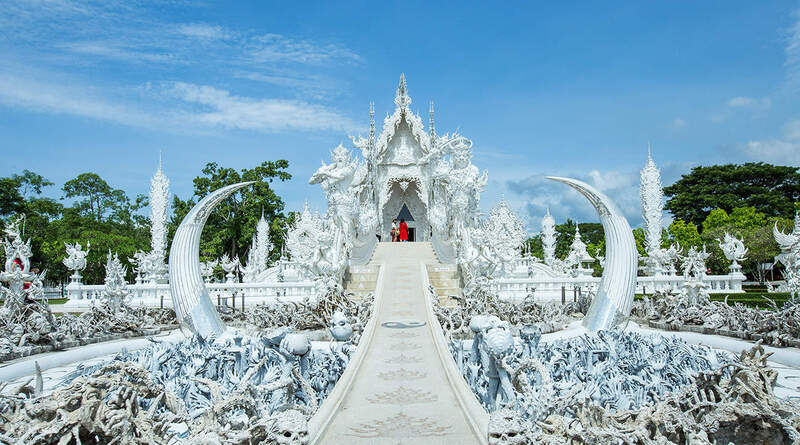
>>> Note: We recommend visiting early in the morning at 8 am when the temple opens, as tour buses arrive later and make the place crowded. Be sure to take pictures upon entering the temple, as you won’t be able to return to the entrance afterward.
Wat Suthat is a 19th-century architectural masterpiece of classical Bangkokian Rattanakosin style. This temple has been well known for housing the biggest meeting hall for worshippers in the capital city of Bangkok. Inside this viharn, there was an imposing 8-meter-tall gilded bronze Buddha statue from the Sukhothai period dating back to the 14th century. The temple area has a cloister courtyard covered with marble; the place is solemn.
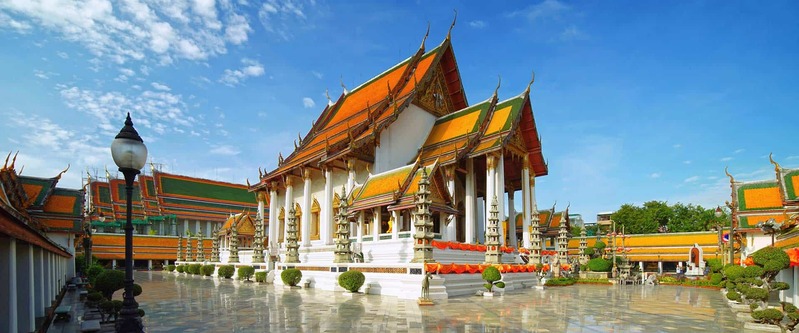
The temple has a special story surrounding it, that of the red teak "giant swing", built 200 years ago. Once used by young Brahmins to honor the god Shiva by trying to reach bags filled with money hanging from the top, this ritual was banned by the king in 1935 due to its dangerousness. But Wat Suthat still continues to attract Brahmins to this day.
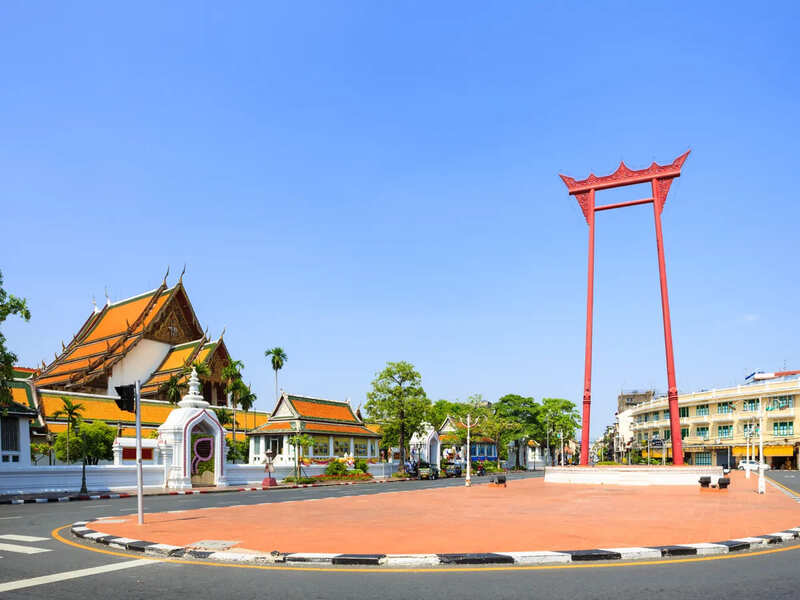
One of the most beautiful Buddhist temples in the region, Wat Mahathat stands at the center of Siam's ancient capital, Ayutthaya, approximately 80 kilometers from Bangkok. This 14th-century monastery still amazes visitors with its architecture—a skillful blend of Khmer and Siamese styles.
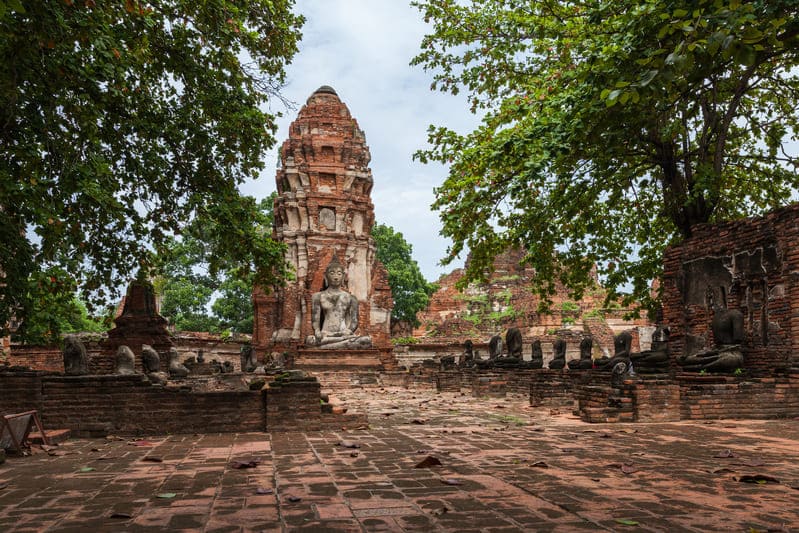
A must-see is the majestic Buddha statue emerging from the roots of a fig tree—a rather unusual and captivating sight. Take a stroll through the large monastery complex to view numerous stupas in their original forms. As a remarkable testament to past grandeur, the Ayutthaya kingdom offers a fascinating journey into the history of Thailand. A visit here is essential for experiencing the aura of ancient Siam.
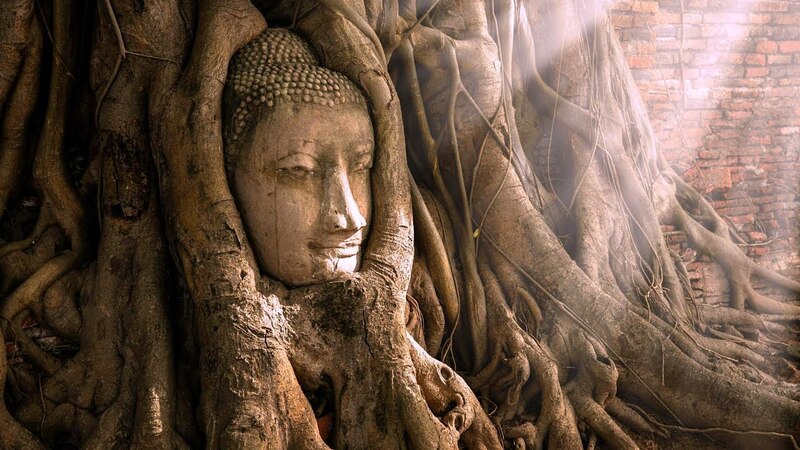
>>> Read More: Ayutthaya, Ancient Royal City
Wat Rong Suea Ten is a very unusual Buddhist temple in the province of Chiang Rai, nicknamed the Blue Temple. Once inside, the omnipresence of blue and the huge tiger heads really make an impression.
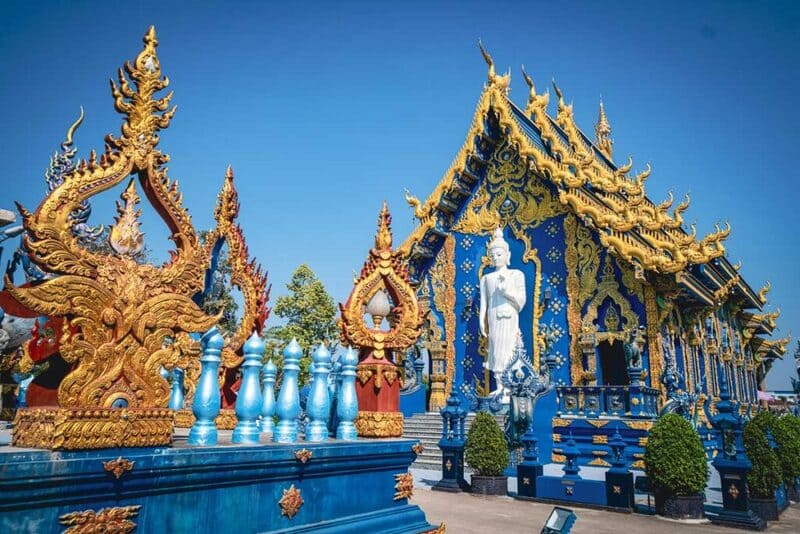
Inside, the deep blue and gold combination creates a unique mystical atmosphere. The richly decorated central stupa contrasts with the sobriety of the blue walls. At nightfall, bluish lighting sublimates the glass bubbles in the garden, creating a magical spectacle.
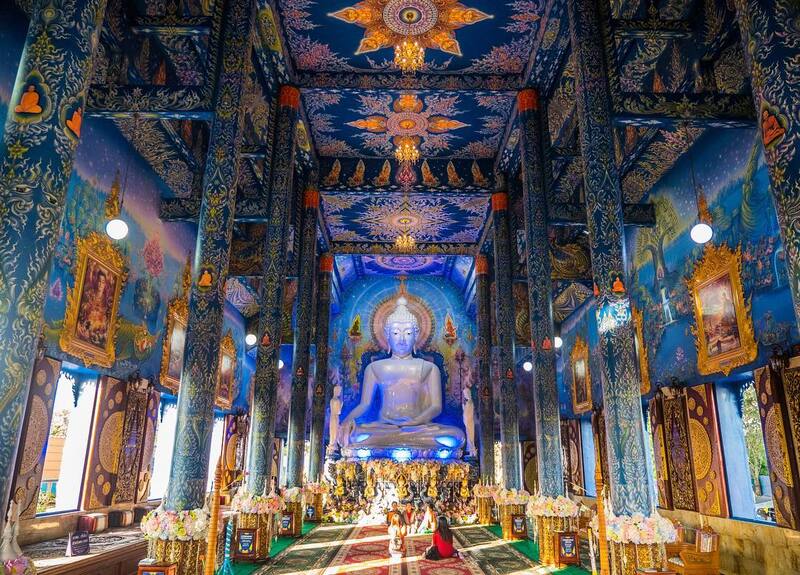
Although recently built, Wat Rong Suea Ten is as beautiful as any ancient temple in the region. Free to enter and offering a truly unique atmosphere, it should definitely be on the list for anyone seeking something remarkable.
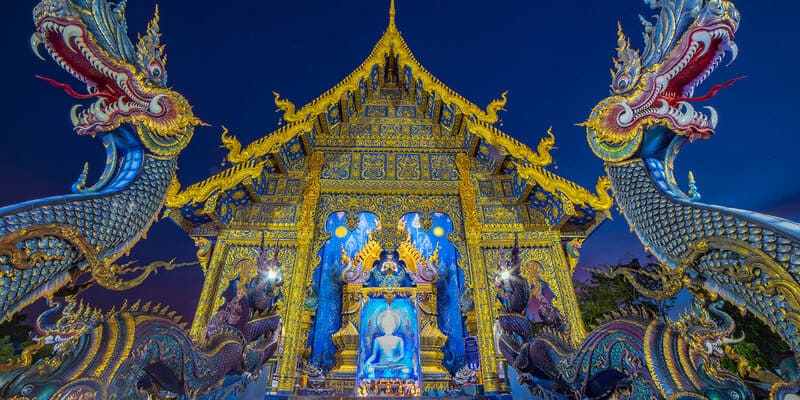
>>> You have an appointment this summer in Chiang Rai, the beautiful region of northern Thailand
Wat Benchamabophit is one of the major and most beautiful temples in Thailand. Its architecture is a remarkable blend of traditional Thai style and modern European influences, giving it a unique and grand appearance. All the columns and floors are covered in marble, which lends the temple a luxurious and majestic feel.
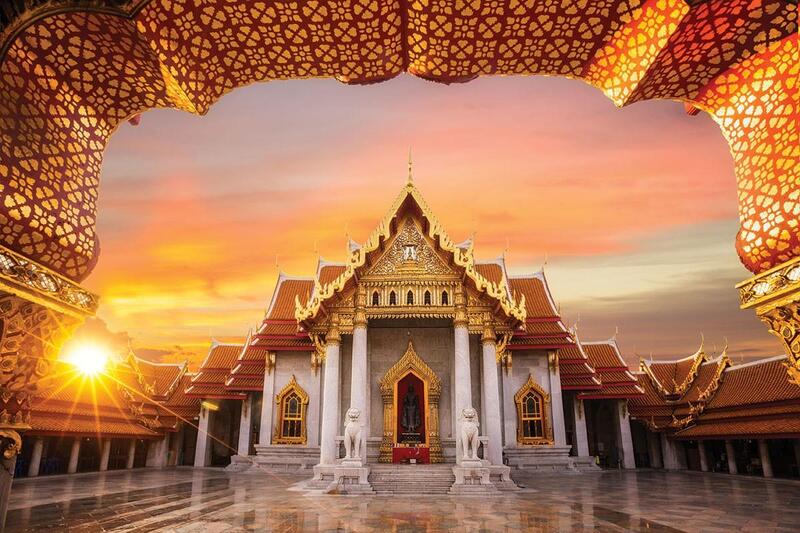
Inside, visitors will find polished sculptures and decorations, with interiors painted in a golden hue. The temple’s highlight is a beautiful and sacred Buddha statue, cast in the twentieth century, known as the Phra Buddha Jinaraj. Wat Benchamabophit is an appealing destination for both Thai tourists and international visitors, offering experiences rich in beauty and spirituality.
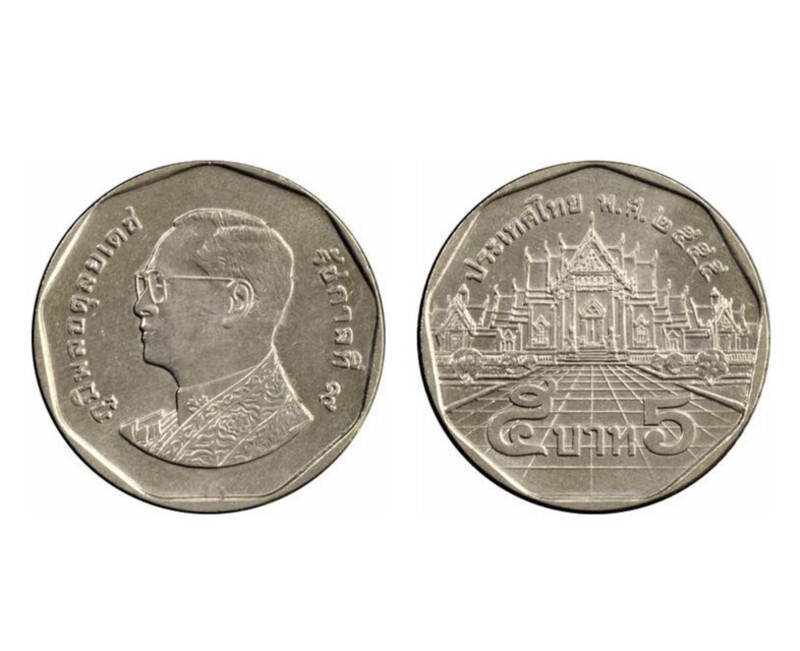
>>> Note: To avoid the heat and crowds, it is recommended to visit the temple between 7 and 8 a.m., wearing appropriate and modest clothing. In hot weather, in particular, the marble floor can become extremely hot, so be cautious if you plan to take photos outside!
Wat Yannawa, also known as the Temple of the Thai Boat, is one of the most popular landmarks in Bangkok. This temple is distinguished by its boat-like shape, symbolizing the historical and cultural significance of boats in trade and transportation in Thailand.
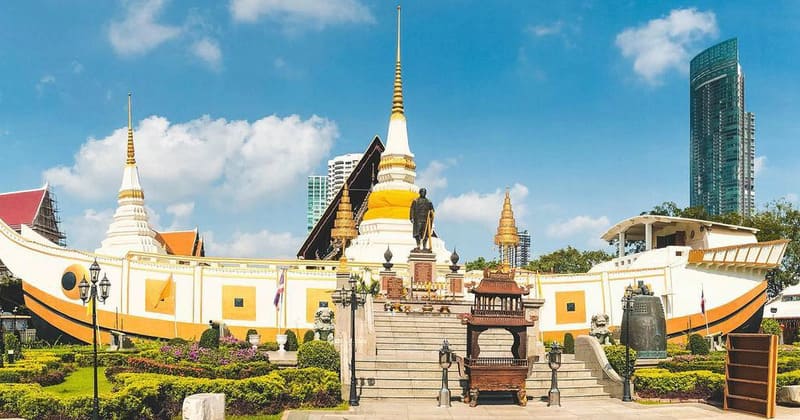
Locals also associate Wat Yannawa with a sacred legend. Directly opposite the Thai Boat Temple, there is an abandoned building across the river. According to the story, in 1955, an Arab merchant planned to develop this land into a 40-story hotel. The temple’s abbot advised him to abandon the project, warning that if built, the hotel would block sunlight from the temple, potentially causing problems due to the temple’s strong spiritual energy. The merchant, however, ignored the warnings and proceeded with his plan. When the building under construction surpassed the temple’s tower in height, misfortunes suddenly befell the merchant’s family, and he himself died in an accident. His frightened family sought to sell the land, but to this day, no one has dared to purchase it.
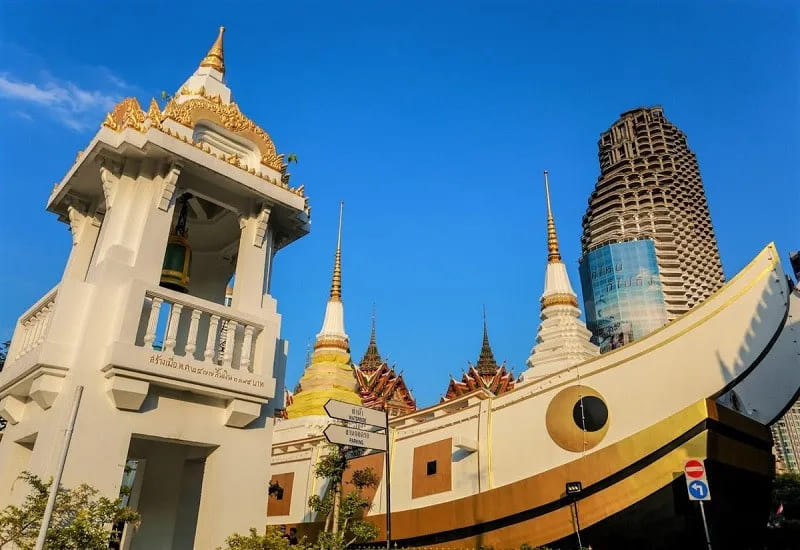
This true story adds to the sanctity of the Thai Boat Temple and draws even more interest from tourists who come to visit.
The Temple of the Golden Buddha, commonly known as Wat Traimit, is one of the most prominent temples in Bangkok, Thailand. This site is famous for housing the world's largest solid gold Buddha statue. According to legend, the statue dates back to the 10th century, before the Burmese invasion of Siam. To protect it from being stolen, monks covered the statue in mud. Later, when Chinese visitors came to Thailand seeking a Buddha statue for worship, they were directed to an old war-ravaged temple with a black Buddha statue. Upon bringing it back, they discovered it was made of gold beneath the outer layer.
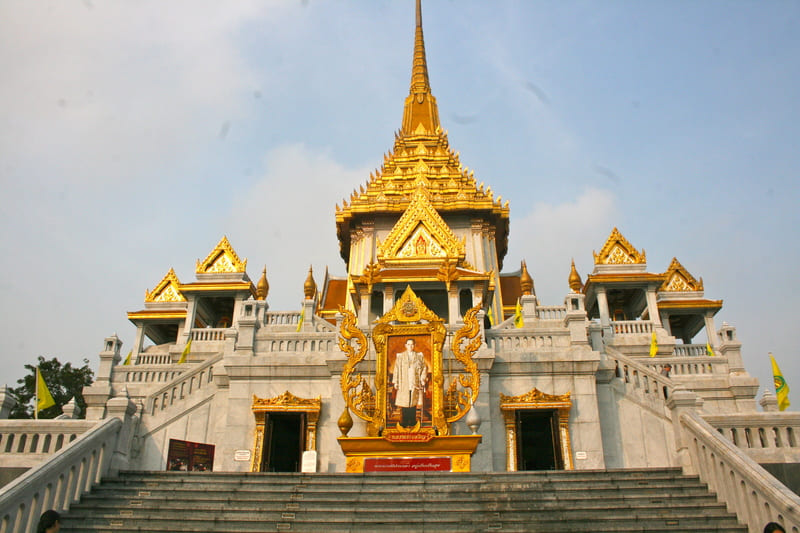
The temple is both a spiritual site and an important cultural and historical symbol, attracting many international visitors who come to admire and learn about the fascinating history surrounding the Golden Buddha statue.
.jpg)
>>> Good to know:
There are some rules which should be followed when going to beautiful Buddhist temples in Thailand in order to preserve the sanctity of such places.
With these tips, your visit to Buddhist temples will take place under the best conditions. You will be able to fully appreciate the peaceful ambience of these havens imbued with spirituality.
Discovering the most beautiful temples in Thailand is an impressive and profound journey. From the delicate beauty of the architecture to the atmosphere of solemnity and tranquility, each temple offers visitors a unique spiritual and cultural experience. Exploring these places is not only about learning about the history and the Buddhist religion, but it is also an opportunity to savor the subtle beauty and deeply feel the spirit of Thailand.
>>> Read also:
>>> Every month, everything you need to know about Thailand
JANUARY | FEBRUARY | MARCH | APRIL | MAY | JUNE | JULY | AUGUST | SEPTEMBER | OCTOBER | NOVEMBER | DECEMBER
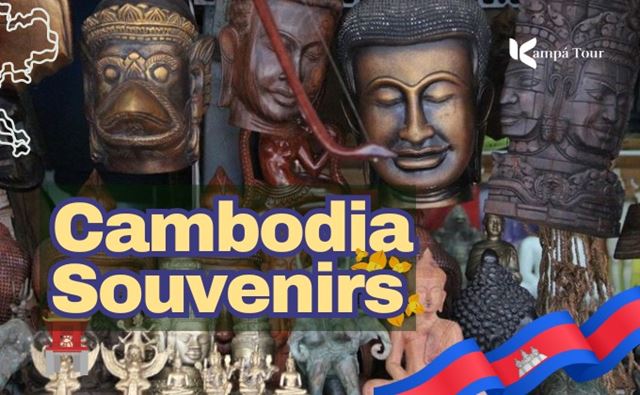
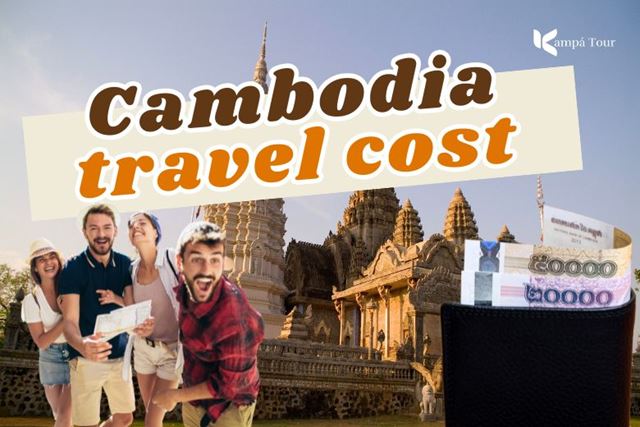
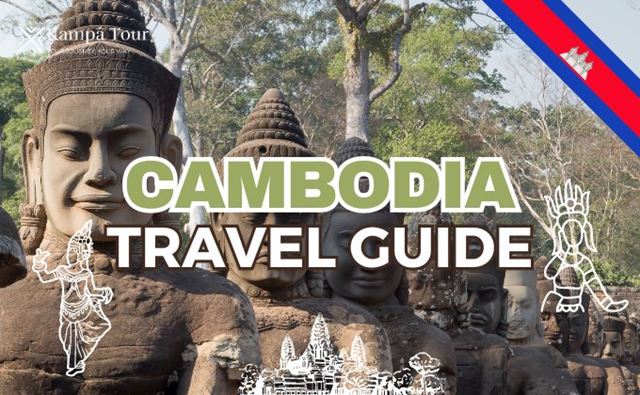
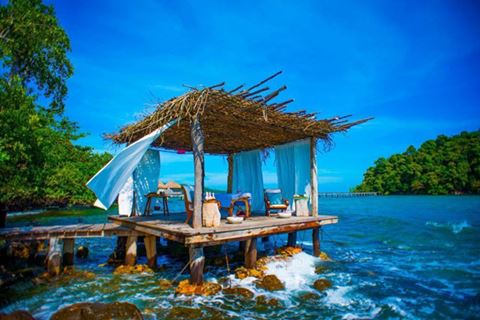 The Essentials
The Essentials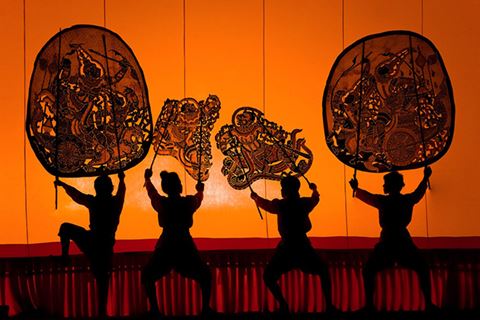 The Essentials
The Essentials The Essentials
The Essentials The Essentials
The Essentials